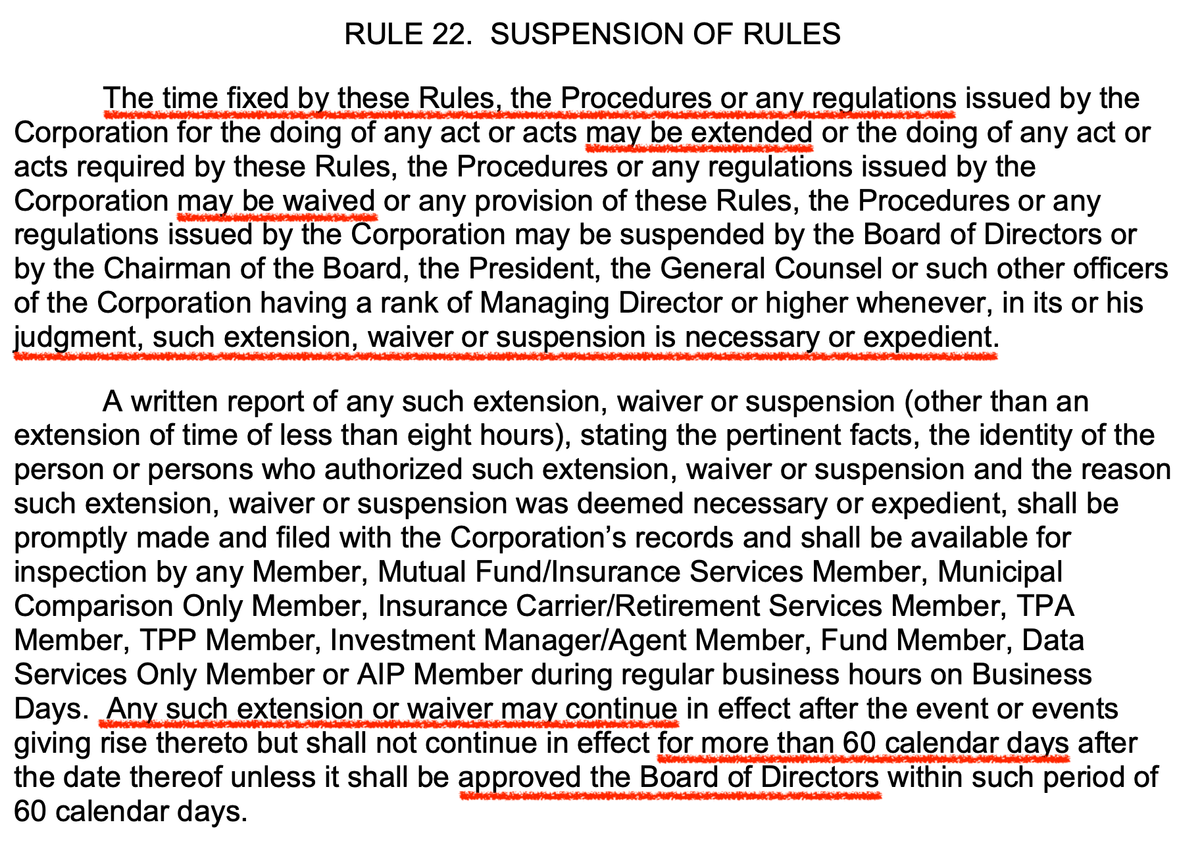SEC Chair Gary Gensler: "Many hedge funds are receiving the vast majority of their repo financing in the non-centrally cleared market, where haircuts or initial margin requirements are not necessarily applied."
"This might create greater risk in times of stress"
The Next “Century of Progress": Remarks before the International Swaps and Derivatives Association Annual Meeting

https://www.sec.gov/news/speech/gensler-remarks-isda-051023
Highlights:
- "Broadly speaking, our proposal would require clearinghouses to ensure that their members bring in all of their repo transactions, both sides of any cash trades executed on an IDB platform, and certain additional cash transactions."
- "Moreover, many hedge funds are receiving the vast majority of their repo financing in the non-centrally cleared market, where haircuts or initial margin requirements are not necessarily applied. This might create greater risk in times of stress, particularly when large, interconnected hedge funds achieve high leverage from banks and prime brokers in the Treasury markets."
- "Thus, for repo transactions, the scope would cover any repo transactions entered into by a clearinghouse member other than with central banks, international financial institutions, or natural persons."
- "On the cash side, in addition to scoping in both sides of the IDB trades, the proposal would scope in trades between clearinghouse members on the one hand and hedge funds, levered accounts, and registered broker-dealers on the other hand. This would help address the potential contagion risk that could flow through to the markets if a hedge fund or levered fund were unable to deliver on a transaction."
- Proposed three key reforms to enhance customer clearing in Treasuries:
- members of a clearinghouse no longer would be able to net their activity against house activity when determining margin.
- broker-dealer customer protection rules would allow the onward posting of customer margin (also known as rehypothecation) to the clearinghouse, subject to a range of protections of those customer funds.
- clearinghouses would need policies and procedures designed to facilitate customer clearing access to these services.
- Despite a regularity of participation consistent with buying and selling securities or government securities as a part of a regular business, a number of these firms, including PTFs, are not registered as dealers or government securities dealers with the Commission.
Debt Ceiling comments:
- "We’ve already seen an effect in the pricing and liquidity of short-dated Treasury bills and continue to monitor for any additional tremors."
- "If the U.S. Treasury as an issuer were actually to default, it would have very significant, hard to predict, and likely lasting effects on investors, issuers, and markets alike."
TLDRS:
- "Broadly speaking, our proposal would require clearinghouses to ensure that their members bring in all of their repo transactions, both sides of any cash trades executed on an IDB platform, and certain additional cash transactions."
- "Moreover, many hedge funds are receiving the vast majority of their repo financing in the non-centrally cleared market, where haircuts or initial margin requirements are not necessarily applied. This might create greater risk in times of stress, particularly when large, interconnected hedge funds achieve high leverage from banks and prime brokers in the Treasury markets."
- "On the cash side, in addition to scoping in both sides of the IDB trades, the proposal would scope in trades between clearinghouse members on the one hand and hedge funds, levered accounts, and registered broker-dealers on the other hand. This would help address the potential contagion risk that could flow through to the markets if a hedge fund or levered fund were unable to deliver on a transaction."
- Proposed three key reforms to enhance customer clearing in Treasuries:
- members of a clearinghouse no longer would be able to net their activity against house activity when determining margin.
- broker-dealer customer protection rules would allow the onward posting of customer margin (also known as rehypothecation) to the clearinghouse, subject to a range of protections of those customer funds.
- clearinghouses would need policies and procedures designed to facilitate customer clearing access to these services.

Full Speech:
Good afternoon. I’m pleased to be back for what I’m told is the fifth time speaking before the International Swaps and Derivatives Association (ISDA). As is customary, I’d like to note that my views are my own as Chair of the Securities and Exchange Commission, and I am not speaking on behalf of my fellow Commissioners or the staff.
May 27 marks 90 years since President Franklin Roosevelt signed the first of the federal securities laws: the Securities Act of 1933.[1]
On that same day, the 1933 Chicago World’s Fair began.[2] In a statement for the grand opening, Roosevelt inaugurated “a century of even greater progress.”[3]
The century of progress that began here in Chicago has lived up to FDR’s vision. Today, our $100 trillion capital markets—with the benefit of the securities laws—have become the deepest, most liquid, most trusted in the world.
It also was in Chicago back in 2012 that, as Chair of the Commodity Futures Trading Commission (CFTC), I spoke with you about work to reform the $700 trillion swaps markets.[4]
Quite a lively discussion ensued. Your then-Chairman Steve O’Connor had lots of questions about bringing central clearing, dealer registration, trading platform regulation, and greater transparency to the swaps markets.[5]
After all we achieved to reform the swaps markets, Scott O’Malia—your CEO and a former fellow CFTC Commissioner—has asked me to return for yet another lively Chicago discussion, this time about our work in the $24 trillion Treasury markets.
These essential markets have their differences, but the policy goals are similar—to bring greater resiliency, efficiency, and competitiveness to the markets.
Treasury Markets
The $24 trillion Treasury markets are the base upon which so much of our capital markets are built. Treasuries are embedded in money market funds. Myriad other markets and financial products are priced off of Treasuries. They are integral to monetary policy. They are how we, as a government and as taxpayers, raise money: We are the issuer.
It wasn’t until 1986—more than 50 years into the century of progress—that Congress passed the Government Securities Act setting up a federal regulatory regime for government securities brokers, dealers, and clearinghouses.[6]
They did so in response to a dozen unregulated government securities firms failing in the 1980s, including Drysdale Government Securities.[7]
We’ve continued to see periodic jitters, though, in these markets.
We saw them in the 1990s. We saw them in the flash crash in 2014, repurchase agreement (repo) problems in 2019, and the dash for cash in 2020. In March of this year, we saw the most significant volatility in the Treasury markets in the last 35 years.[8]
Given the critical importance and periodic jitters of these markets, I’m proud that the SEC—working alongside the Department of the Treasury and the Federal Reserve—has taken on important projects to enhance the resiliency, efficiency, and competitiveness of the Treasury markets.
No doubt, you’ll recognize the main tools underlying our proposals: broadening central clearing, registering dealers, regulating trading platforms, and promoting greater transparency.
Policy Projects
Clearing
Clearinghouses sit in the middle of the capital markets, reducing risk amongst and between counterparties through multi-party netting. Rather than having thousands of bilateral or tri-party relationships amongst market participants, clearinghouses offer a classic hub and spoke model. Further, central clearing reduces risk through the robust rules of the clearinghouses themselves, including for the collection of initial and variation margin.
Clearinghouses have lowered risk for the public and fostered competition in the capital markets since the 19th century.
They didn’t come to the Treasury markets, though, until 1986. Just weeks after Congress passed the Government Securities Act, the first clearinghouse for government securities was incorporated: the Government Securities Clearing Corporation.[9]
Initially, during the 1990s, we saw a rise in the amount of Treasury securities that were centrally cleared. Given various changes in the marketplace, subsequently we saw a reversal of this.[10] By 2017, only 13 percent of Treasury cash transactions were fully centrally cleared.[11] Interdealer brokers (IDBs) often are bringing just one side of the trade into central clearing when one of the counterparties is not also a member of the clearinghouse.[12]Such reduced clearing increases system-wide risk.
Thus, we proposed rules to broaden the scope of transactions in the Treasury markets required to be brought into central clearing.[13]
Broadly speaking, our proposal would require clearinghouses to ensure that their members bring in all of their repo transactions, both sides of any cash trades executed on an IDB platform, and certain additional cash transactions.
Repos, the form of funding for much of the debt markets, were at the center of the jitters in the Treasury markets in 2019. Moreover, many hedge funds are receiving the vast majority of their repo financing in the non-centrally cleared market, where haircuts or initial margin requirements are not necessarily applied.[14] This might create greater risk in times of stress, particularly when large, interconnected hedge funds achieve high leverage from banks and prime brokers in the Treasury markets.
Thus, for repo transactions, the scope would cover any repo transactions entered into by a clearinghouse member other than with central banks, international financial institutions, or natural persons.
On the cash side, in addition to scoping in both sides of the IDB trades, the proposal would scope in trades between clearinghouse members on the one hand and hedge funds, levered accounts, and registered broker-dealers on the other hand. This would help address the potential contagion risk that could flow through to the markets if a hedge fund or levered fund were unable to deliver on a transaction.
Further, we also proposed three key reforms to enhance customer clearing in Treasuries.[15]
First, members of a clearinghouse no longer would be able to net their activity against house activity when determining margin. Second, broker-dealer customer protection rules would allow the onward posting of customer margin (also known as rehypothecation) to the clearinghouse, subject to a range of protections of those customer funds. Third, clearinghouses would need policies and procedures designed to facilitate customer clearing access to these services.
Additionally, the Commission voted to propose rules to strengthen the governance of registered clearinghouses, particularly with respect to conflicts of interest and the use of service providers.[16]
Dealers
A key part in the century of progress is that in the 1930s, Congress gave the SEC authority to register brokers and dealers in the securities markets.
Then, as part of the 1980s reforms, Congress gave the SEC clear authority to register government securities dealers.
After the 2008 financial crisis, Congress gave similar authorities to the CFTC and SEC to register swap dealers.
In the last couple of decades, certain market participants, including principal trading firms (PTFs), started participating significantly in the Treasury markets. In 2020, PTFs represented around 60 percent of the volume on the IDB platforms in the Treasury markets.[17]
Despite a regularity of participation consistent with buying and selling securities or government securities as a part of a regular business, a number of these firms, including PTFs, are not registered as dealers or government securities dealers with the Commission.
It’s time to seal this regulatory gap.
Thus, we proposed rules to fulfill Congress’s statutory intent. The rules would further define a dealer so that market participants who are in the business of providing liquidity in Treasuries or other securities register with the SEC and comply with securities laws.[18]
This could help level the playing field among firms and enhance the resiliency of our markets.
Further, the Commission re-proposed amendments to Rule 15b9-1 to require broker-dealers in the markets to register with the Financial Industry Regulatory Authority (FINRA).[19] By extending FINRA oversight to potentially dozens of broker-dealers, the proposed amendments would strengthen oversight of firms trading securities across several markets.
Platforms
After the ’33 Act became law, Roosevelt and Congress knew their work wasn’t done. The following year, they passed the Securities Exchange Act of 1934 that covered intermediaries such as the exchanges themselves.
The basic idea was the public deserves protection not only when a security is issued, but on an ongoing basis when a security is traded in secondary markets. Over the years, investors and issuers alike have benefitted from well-regulated exchanges and trading platforms.
Much of the Treasury secondary market now is facilitated by electronic trading platforms: IDBs as well as request-for-quote (RFQ) platforms between dealers and customers. These platforms, though, are yet to be registered as exchanges or alternative trading systems.
Thus, last year, the Commission issued a proposal to require significant trading platforms—including in the Treasury markets—to come under important rules for the markets.[20]
The proposal would require IDBs in the government securities markets to comply with Regulation ATS and Regulation Systems Compliance and Integrity. These IDBs function like exchanges but currently are not regulated like exchanges.
The proposal also would modernize our rules regarding the definition of an exchange. This would account for the evolving nature and electronification of trading platforms. In particular, the proposal would require communication protocol systems—venues that bring together buyers and sellers of securities through structured methods to negotiate a trade—to comply with rules for exchanges.
Further, the Commission last month issued a supplemental release to the proposal to address comments from various market participants, including those in the crypto markets.[21]
Transparency
During the century of progress, investors, issuers, and markets alike have benefitted from transparency in the securities markets. This has been true in the equity markets, much of the fixed-income markets, and more recently in the swaps markets.
That’s why, in addition to the work by the Commission, I support the U.S. Treasury[22] and FINRA’s[23] ongoing efforts to enhance post-trade transparency in the Treasury markets. Further, our proposed amendments to Rule 15b9-1, through extending FINRA oversight to more broker-dealers, would bring more data into the Trade Reporting and Compliance Engine (TRACE).
Debt Ceiling
Before I close, I’d like to say a few words regarding the ongoing discussions in Washington around the debt ceiling.
While we at the SEC have no direct role in those discussions, the outcome is directly consequential to each part of our mission: protecting investors, facilitating capital formation, and maintaining fair, orderly, and efficient markets.
We’ve already seen an effect in the pricing and liquidity of short-dated Treasury bills and continue to monitor for any additional tremors.
If the U.S. Treasury as an issuer were actually to default, it would have very significant, hard to predict, and likely lasting effects on investors, issuers, and markets alike.
In a word, it would make the Cyclone Roller Coaster at the 1933 Chicago World’s Fair look like a kiddie ride.[24]
Conclusion
This is the second time I’ve spoken to an ISDA annual meeting in Chicago about market structure—once about swaps, and once about Treasury markets.
Though these markets are different, both are essential to our economy. Investors and issuers alike benefit when these markets are resilient, efficient, and competitive.
Since that first speech, I believe we achieved a great deal in the swaps markets to advance these goals.
I think it’s critical that, given their size and periodic jitters, we also update the Treasury markets. The main tools underlying our proposals may be applied differently, but they’re every bit as important to consider.
If Roosevelt were with us today in Chicago, he might say that’s how we prepare for the next century of progress.
Over to you, Scott. This being the Windy City, I’m prepared for a breezy conversation.


